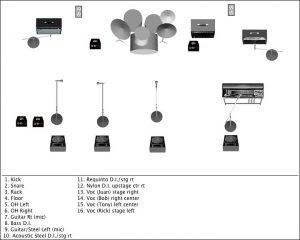
Every touring band needs a stage plot. You’ll be making the lives of club owners, venue bookers, and live-sound engineers much easier by sending them an accurate stage plot and input list well in advance of your show.
You’ll also make your load-in, setup, and soundcheck experience more efficient.
What is a stage plot?
A stage plot is a visual representation that illustrates your band’s live performance setup, band member placement on stage, what gear you use, and any other helpful information to the venue.
What do I include?
- Visual representation of where each member is positioned on stage.
- The names of each member and what instruments they play.
- How many mics, DIs, monitors, and cables (XLRs or 1/4 inch) you’ll need the venue to provide.
- What sound gear, if any, you’ll be providing.
- Whether or not bass and keyboard amplifiers have balanced outputs. Will they be mic’d or run direct?
- Where the amps will be placed in relation to the players.
Here are a couple basic stage plot examples.


How can I create a stage plot?
If you just need something free and easy, check out this free Stage Plot Designer. It doesn’t need to be neat and pretty, it only needs to be accurate. I encourage adding any technical or logistical details as well. Using a stage plot designer like this helps you visualize and organize the entire stage and includes drag and drop features so you don’t need to start from a blank piece of paper.
What can I use if I’m in a rush?
If you find yourself in a situation where you need to draw your stage plot last-minute, and hopefully NOT on a napkin, you can use the following symbols to make things clear.
- Use a series of circles to stand for the drum set.
- Microphones are denoted by an X inside of a circle.
- Amps are rectangles.
- Stage wedges are triangles.
- Keyboards, guitars, basses, DJ stations,… you might need to use some of your grade-school doodling skills.
If you can’t create a stage plot, at least send the venue an informal input list.
For instance:
Dave- Standard 2-tom drum kit. Mic for kick. Mic for snare/hat. One overhead. Vocal mic on boom stand. Monitor to his left.
Janet- acoustic & electric guitar. stands front center stage. Vocal mic on boom stand. Guitar amp to the left of drum monitor. Also, DI for acoustic guitar.
Peter- electric bass. stands stage left. boom mic for vocals. bass rig sits rear stage left, has balanced out.
Alice- 2 keyboards, both going into single keyboard amp with balanced out. Also one vocal mic on boom stand that doubles as trumpet microphone.
So what do I do with my stage set diagram?
Email it to the booker, promoter, or talent-buyer the moment your gig is confirmed. Also, ask them if you can get the contact info for the live-sound engineer and send it to them. The booker may also send you an email or contract with lots more information about the gig. The sound person’s contact info might be on there too. Be sure to check.
Then, show up, have fun, put on a great show, and sell some music!
-Chris R. at CD Baby
